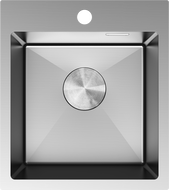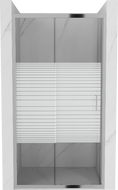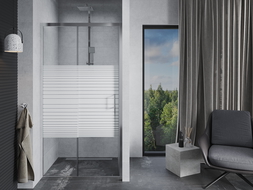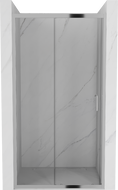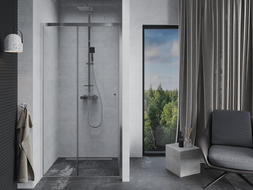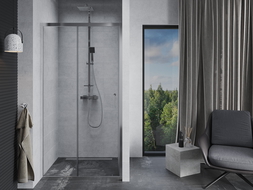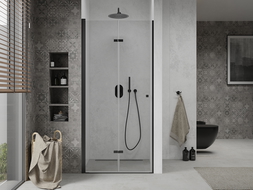
You step out of the cabin and... disaster! You land with your foot in a cold puddle and slip uncontrollably. For a moment, you balance to regain your footing. Finally, after painfully banging your elbow against the handle, you achieve a stable position. Like Sherlock Holmes, you begin to investigate the cause of the water appearing in the bathroom. You already know! It's the leaky shower cabin that is the culprit of this unfortunate incident. You need to quickly locate the source of the leak and seal the shower. How to do that? This will be covered in the following part of the article.
Unpleasant Consequences of Shower Cabin Leakage
Leaks in the shower cabin are a significant problem. Water escaping with soap, shampoo, or other cosmetic products causes the bathroom floor to be slippery, posing a danger to users. Unsightly stains appear on the floor, which over time can turn into hard-to-remove stone deposits. Escaping water increases humidity in the bathroom, and its accompanying high temperatures create a specific microclimate that fosters the growth of mold and mildew. These not only emit unpleasant odors but are also harmful to health. Water from a leaky cabin can seep into the walls and floor, and even - in the case of prolonged accumulation beneath the tiles - flood lower floors. Therefore, it's essential to determine the leak's location as quickly as possible and seal the shower cabin. Proper sealing and protection of the cabin from leaks will help us avoid unpleasant consequences.
When the Shower Cabin is Leaking, Track Down the Cause of the Malfunction!
One of the most common causes of water leakage from the shower cabin is worn-out or damaged seals. We can find them along each longer edge of the door and at the bottom, where the lower part of the door wing meets the shower tray. At first glance, they may be invisible and seem inconspicuous, yet they can be the cause of the leaks that appear in the shower doors. Therefore, it is crucial to monitor their condition and regularly clean them to prevent mold buildup. Seals, due to their continuous contact with water and detergents, are among the fastest-wearing elements in any cabin. If we notice that one of them is damaged, we should replace it immediately. It is important to keep track of their condition, which includes regular cleaning and replacing.
How to Seal the Shower Cabin Without Professional Help?
Replacing the shower seals is incredibly simple and does not require professional intervention. All you need is to acquire the necessary materials, and you can get to work. Shower seals differ in size, appearance, and application. When choosing the right model, consider the following aspects:
- the thickness of the cabin wall to which we match the seals,
- the width of the gap between the door wings,
- the installation location of the seal,
- the shape of the cabin where it will be installed.
Replacing the Seal in the Shower Cabin Door
Start the replacement by removing the worn or damaged seal and thoroughly cleaning the entire glass surface to remove any contaminants. The glass should be scrupulously clean. Once prepared, we insert the new seal and press it down firmly. Lubricating the glass with dish soap will facilitate the installation. If the seal is a bit too large, we can apply a small amount of clear silicone. If we purchase a seal longer than the height of the cabin, it is enough to trim it appropriately. If we intend to install seals at the contact point of the door wings, it's worth choosing magnetic models. The built-in magnet ensures that the seals adhere perfectly together, providing 100% sealing. Remember, once the seal is installed, it cannot be moved, so we must install it correctly right away.
Silicone - the Specialist in Wet Work, or the Continuation of Sealing the Shower Cabin
Even after replacing the seals, the problem may not be solved, and the leaking shower cabin continues to keep us awake at night. What else do we need to do to seal the shower cabin? We need to check whether all gaps have been properly secured with silicone. It may turn out that the source of the mess is a leak from beneath the tray, caused by the deterioration of old silicone or improper sealing of the joints. In that case, it's a good idea to use sanitary silicone, which is not only resistant to high humidity and temperature fluctuations but also has fungicidal properties. Old sealing needs to be carefully removed with a special knife and silicone remover, and then new silicone should be applied using a special gun.
Keep Up with Regular Sealing of the Shower Tray
The tendency to leak is most often present in a cabin equipped with a shower tray. If we live in a multi-story house, a leak-proof tray is particularly important as it protects against flooding neighbors living below us. Therefore, it is necessary to ensure thorough sealing not only of the cabin itself but also of the floor around it. The most crucial places that require sealing with silicone include:
- the junction of the tray with every adjacent wall,
- the gaps between the cabin and the tray,
- the joints between the edge of the tray and the tiles inside the shower,
- areas where the shower profiles are screwed to the wall.
For sealing shower cabins and trays, we should choose products resistant to detergents and significant temperature differences as well as UV radiation, namely sanitary silicones designed specifically for high-humidity environments. Such sealants provide a 100% guarantee of tightness and protect against unpleasant surprises.







